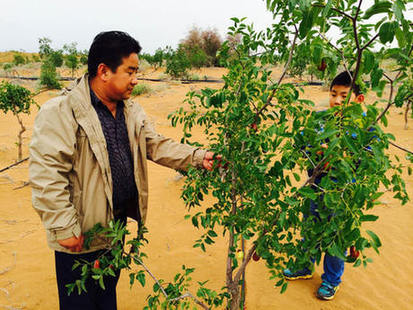Taming Shapotou’s Tengger Desert
When the Baotou-Lanzhou Railway officially opened on August 1, 1958, a system of desertification control was established to ensure that this artery of northwestern China continued to pulse for over 50 years. New Zealand-born writer Rewi Alley, an old friend of China, wrote after his visit to Shapotou that the success of the railway through the Tengger Desert was an example of railway construction in desert areas for the whole world to see.
The UN Conference on Desertification, held in the Kenyan capital, Nairobi, in 1977, concluded that the success of sand control using vegetation in regions with an annual precipitation of less than 200 mm and no irrigation was widely regarded as pioneering work. Experts and scholars from over 10 countries came to Shapotou to learn from the Chinese mode of sand control.
“In 1982, National Geographic first introduced Shapotou’s grass pane sandfence to the outside world,” Li Xinrong, director of the CAS Shapotou Desert Research and Experiment Station, recalled proudly. “Countries including South Africa, Saudi Arabia and Egypt went on to adopt this distinctive method.” Nowadays, the station has established cooperation with multiple nations including the U.S., Germany, Italy, Norway, Sweden, Israel, Japan, Turkmenistan and Mongolia.
On July 5, 1994, World Environment Day, Shapotou’s desert ecological restoration program won the Global 500 Roll of Honour set by the United Nations Environment Programme.
Yang Fei, 43, a rural entrepreneur in his own circular ecological park in Shapotou. Zhou Lin

Circular Economy in the Desert
Yang Fei, 43, a rural entrepreneur in Shapotou, made his fortune through innovative growing of watermelons in gravel and sand. The fruits of his labor were served up during the 2008 Beijing Olympic Games. After years of hard work, Yang is now chairman of Ningxia Xiangyan Group, the parent company of a number of brands ranging from watermelons and vegetables to organic milk, forming a typical circular economic industry chain in the desert.
Cultivated in gravel and sand in Shapotou, Xisha watermelons are rich in selenium, an anti-cancer anti-oxidant. Yang recalled that in 1998 two businessmen from Sichuan Province offered to buy his watermelons at an above-market price. Realizing his fruit’s vast potential, Yang set up his own business contracting 3.4 hectares of land to grow Xisha watermelons and transport them to other provinces. When Yang’s company finally established Ningxia Xiangyan Group with his own brand Xiangshan Lühao, his produce had already entered markets in Hong Kong, Southeast Asia and Kyrgyzstan.
With the help of local government, Shapotou’s Xisha Watermelons were specially served to sports delegations during the 2008 Beijing Olympic Games. This earned Yang a cool RMB 10 million. After accumulating certain economic strength, Yang began to build greenhouses to grow organic fruits and vegetables. By 2012, 133 hectares of vineyard, 3,000 greenhouses and 167 hectares of fruit trees had been established and planted.
When asked about the secret of his success, Yang said that both he and his wife were diligent and would work from dawn to dusk. Yang holds a strong belief that the desert is full of treasures to be discovered. Gifted with an aptitude in business and management, Yang said, “It takes at least five years to benefit from growing grapes and orchards, compared to which raising dairy cattle is a short-term business. In fact, it is a wise choice to rear cows on sand: The weather is so dry that insects and viral infections cannot thrive. The soft sand provides natural bedding for cows and cattle manure fermentation can save huge amounts spent on fertilization, equal to RMB 2-3 million.”
